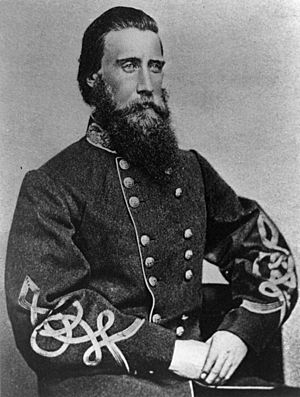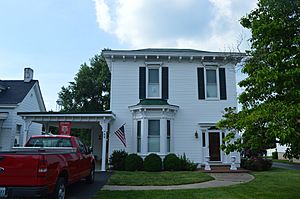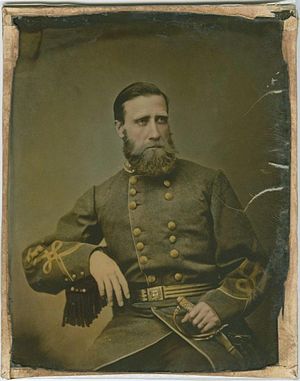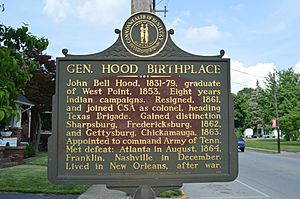John Bell Hood facts for kids
Quick facts for kids
John Bell Hood
|
|
|---|---|

Lt. Gen. John Bell Hood
|
|
| Nickname(s) | Sam |
| Born | June 1, 1831 or June 29, 1831 Owingsville, Kentucky |
| Died | August 30, 1879 (aged 48) New Orleans, Louisiana |
| Place of burial |
Metairie Cemetery, New Orleans, Louisiana
|
| Allegiance | United States of America Confederate States of America |
| Service/ |
United States Army Confederate States Army |
| Years of service | 1853–1861 (US) 1861–1865 (CSA) |
| Rank | |
| Commands held | 4th Texas Infantry Texas Brigade Hood's Division, First Corps, Army of Northern Virginia Second Corps, Army of Tennessee Army of Tennessee |
| Battles/wars | American Indian Wars American Civil War |
| Signature | |
John Bell Hood (June 1 or June 29, 1831 – August 30, 1879) was a Confederate general during the American Civil War. Hood had a reputation for bravery and aggressiveness that sometimes bordered on recklessness. Arguably one of the best brigade and division commanders in the Confederate States Army.
Contents
Early life
John Bell Hood was born in Owingsville, Kentucky, the son of John Wills Hood (1798–1852), a doctor, and Theodosia French Hood (1801–1886). He was a cousin of future Confederate general G. W. Smith and the nephew of U.S. Representative Richard French.
Education and early career
French obtained an appointment for Hood at the United States Military Academy, despite his father's reluctance to support a military career for his son. Hood graduated in 1853, ranked 44th in a class of 52 that originally numbered 96, after a near-expulsion in his final year for excessive demerits (196 of a permissible 200). At West Point, as well as during his later Army years, he was known to friends as "Sam."
Notwithstanding his modest record at the academy, in 1860, Hood was appointed chief instructor of cavalry at West Point, a position he declined, citing his desire to remain with his active field regiment and to retain all of his options in light of the impending war.
Hood was commissioned a brevet second lieutenant in the 4th U.S. Infantry, served at Fort Jones, California, and later transferred to the 2nd U.S. Cavalry in Texas, where he was commanded by Col. Albert Sidney Johnston and Lt. Col. Robert E. Lee. While commanding a reconnaissance patrol from Fort Mason on July 20, 1857, Hood sustained the first of many wounds that marked his life in military service – an arrow through his left hand during action against the Comanches at Devil's River, Texas. He was promoted to first lieutenant in August 1858.
Military career
At the start of the Civil War, he offered his services to his adopted state of Texas. He achieved his reputation for aggressive leadership as a brigade commander in the army of Robert E. Lee during the Seven Days Battles in 1862, after which he was promoted to division command.
He led a division under James Longstreet in the campaigns of 1862–63. At the Battle of Gettysburg, he was severely wounded, rendering his left arm useless for the rest of his life. Transferred with many of Longstreet's troops to the Western Theater, Hood led a massive assault into a gap in the Union line at the Battle of Chickamauga, but was wounded again, requiring the amputation of his right leg.
Hood returned to field service during the Atlanta Campaign of 1864, and at the age of 33 was promoted to temporary full general and command of the Army of Tennessee at the outskirts of Atlanta, making him the youngest soldier on either side of the war to be given command of an army. There, he dissipated his army in a series of bold, calculated, but unfortunate assaults, and was forced to evacuate the besieged city.
Leading his men through Alabama and into Tennessee, his army was severely damaged in a massive frontal assault at the Battle of Franklin and he was decisively defeated at the Battle of Nashville by his former West Point instructor, Maj. Gen. George H. Thomas, after which he was relieved of command.
Post war
After the war, Hood moved to Louisiana and became a cotton broker and worked as president of the Life Association of America, an insurance business. In 1868, he married New Orleans native Anna Marie Hennen, with whom he had 11 children over 10 years, including three pairs of twins. He also served the community in numerous philanthropic endeavors, assisting in fund-raising for orphans, widows, and wounded soldiers.
During the postwar period, he began a memoir, Advance and Retreat: Personal Experiences in the United States and Confederate States Armies. Though rough, incomplete and not published until after his death, this work served to justify his actions, particularly in response to what he considered misleading or false accusations made by Joseph E. Johnston, and to unfavorable portrayals in William Tecumseh Sherman's memoirs.
His insurance business was ruined by a yellow fever epidemic in New Orleans during the winter of 1878–79. Then Hood himself succumbed to the disease, dying six days after his wife Anna succumbed and on the same day their eldest daughter Lydia died, leaving 10 destitute, orphaned young children. They received support for over twenty years from the Texas Brigade Association and were ultimately adopted by seven different families in Louisiana, Mississippi, Georgia, Kentucky, and New York.
Legacy
John Bell Hood is interred in the Hennen family tomb at Metairie Cemetery in New Orleans. He is memorialized by Hood County in Texas, and formerly, the U.S. Army installation, Fort Cavazos which was named Fort Hood, in central Texas.
Images for kids
See also
 In Spanish: John Bell Hood para niños
In Spanish: John Bell Hood para niños






